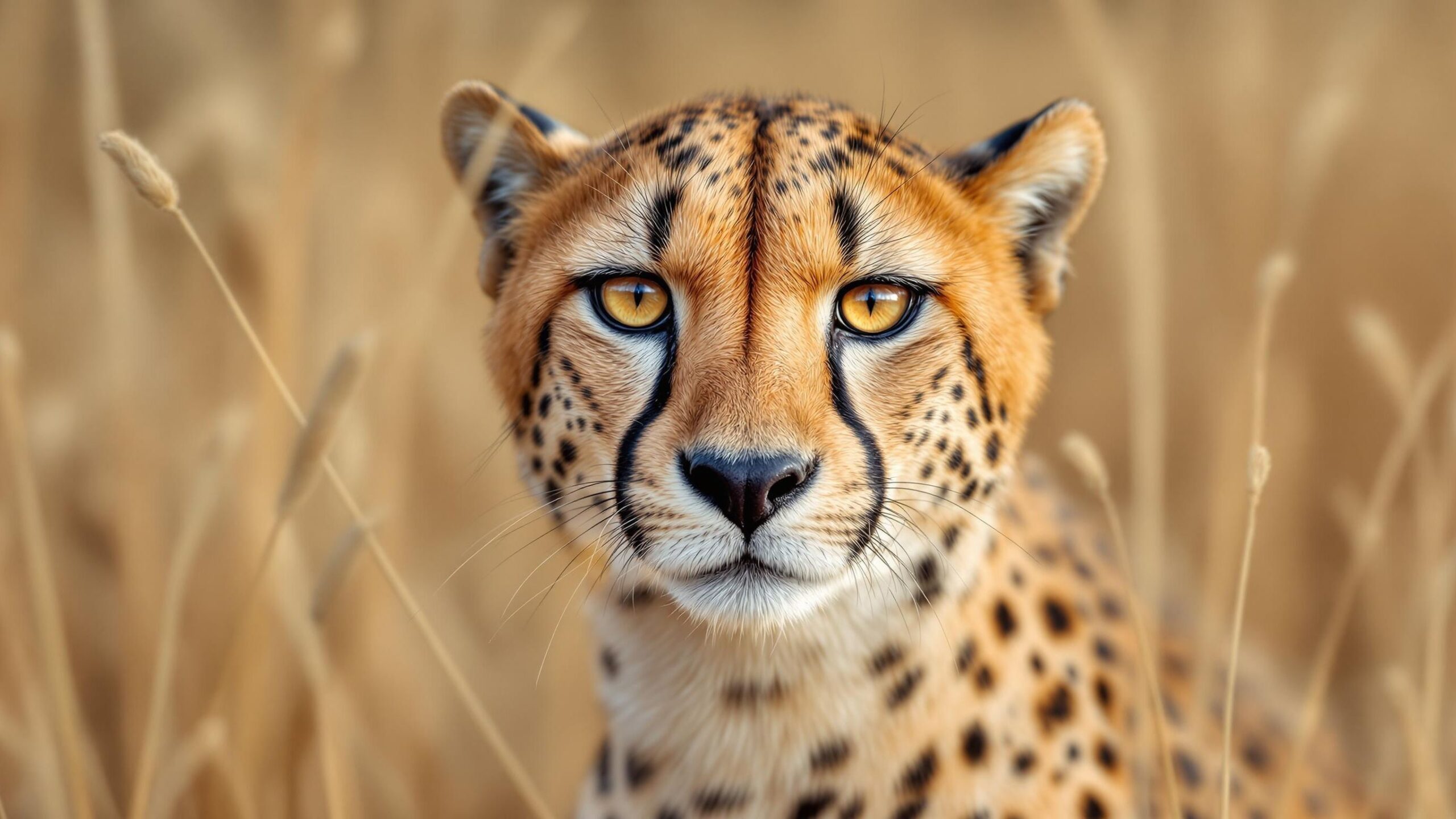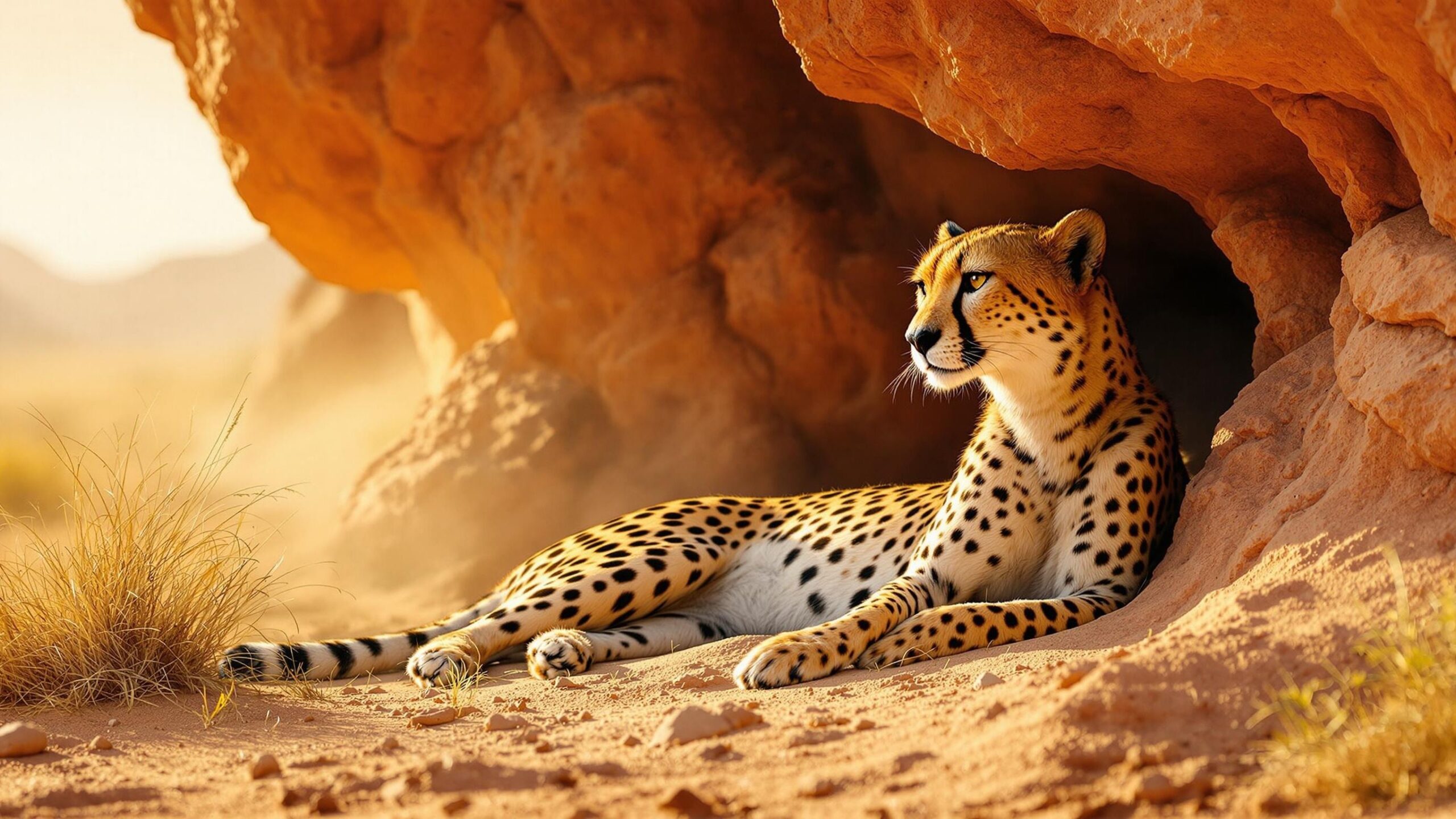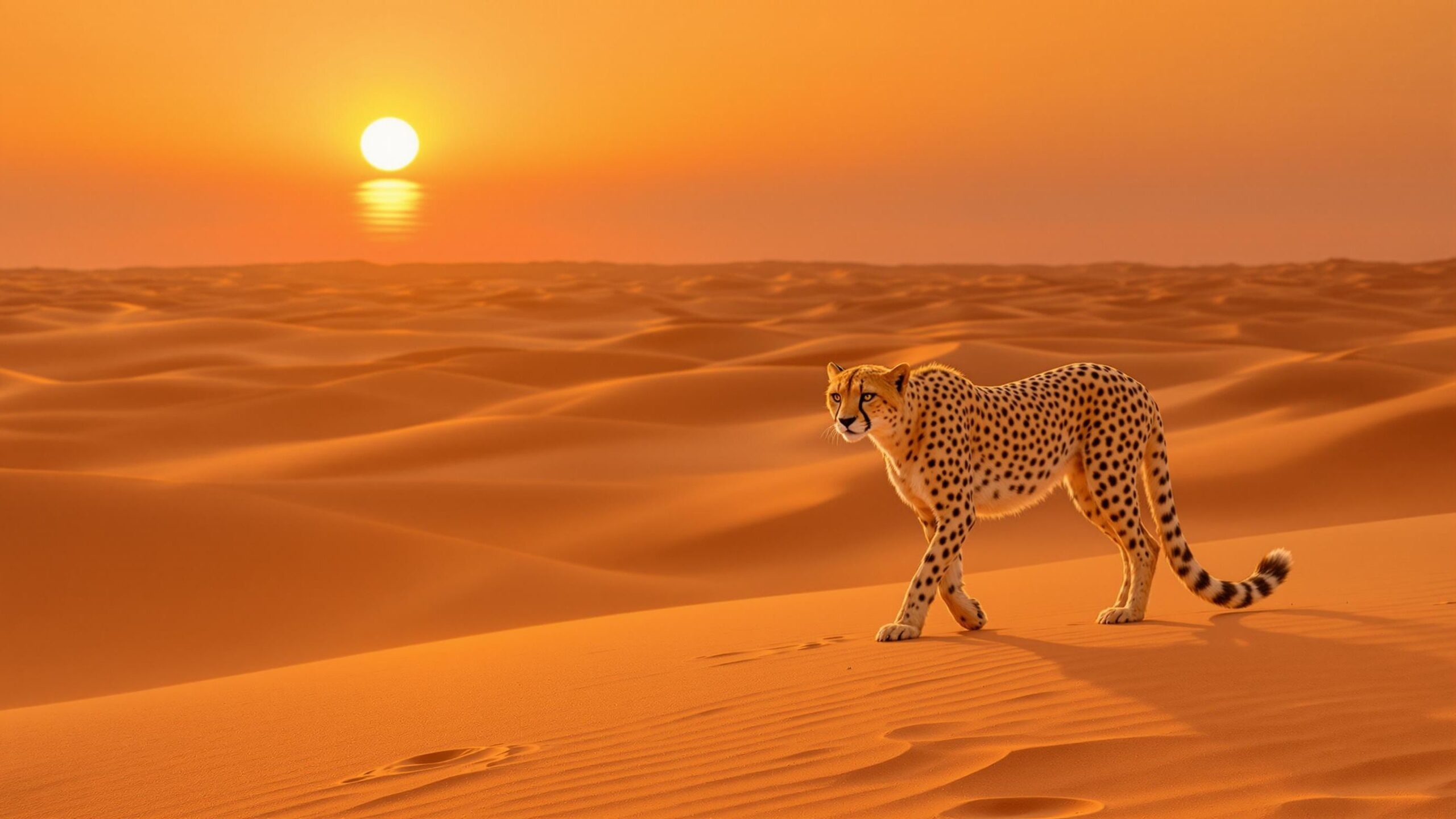Northwest African Cheetah: The Phantom of the Desert
In the sun-scorched expanses of the Sahara and the sparse grasslands of the Sahel, there exists a creature so elusive that it is rarely seen, even by those who spend their lives studying wildlife. With pale fur, haunting eyes, and a ghostlike presence, the Northwest African Cheetah (Acinonyx jubatus hecki)—also known as the Saharan cheetah—is one of the rarest and most mysterious large cats on the planet. A distant cousin of its faster, more well-known southern relatives, this cheetah has adapted to survive in some of the harshest and most inhospitable terrain on Earth.
Although its population is critically endangered, and sightings are vanishingly rare, the Northwest African Cheetah continues to quietly endure, embodying the resilience and grace of the desert itself. In this article, we journey into its world—examining its biology, behavior, habitat, and significance—not just as a subspecies, but as a living symbol of survival against all odds.
A Subspecies Apart
The Northwest African Cheetah is one of five recognized subspecies of Acinonyx jubatus, and arguably the most enigmatic. Its scientific name, Acinonyx jubatus hecki, pays tribute to German zoologist Eduard Rüppell and taxonomist Karl Heck, who first recognized the animal’s unique characteristics in the 19th century. Unlike its southern relatives, the Saharan cheetah has developed specific adaptations that allow it to thrive in extreme desert conditions.
Smaller and lighter in build than the Southeast African cheetah, A. j. hecki typically displays a noticeably paler coat, often with reduced or faint spotting. This lighter coloration provides better camouflage against the sandy dunes and rock-strewn terrain of its desert home. Its facial markings, including the iconic black “tear lines” that run from the eyes to the mouth in other cheetah subspecies, are often much less pronounced or entirely absent, giving the Saharan cheetah a somewhat ghostly and ethereal appearance. Physically, it retains the hallmarks of the species: a streamlined body built for speed, long legs, a flexible spine, and a tail that acts as a counterbalance during rapid maneuvers. But in the case of the Northwest African Cheetah, speed is not everything. In the desert, stamina, stealth, and endurance often matter more than raw acceleration.
Habitat: The Edge of Survival
The natural range of the Northwest African Cheetah spans parts of the Sahara and Sahel regions, including Algeria, Mali, Niger, Benin, and Chad. Some of its most secure strongholds lie within remote protected areas such as the Ahaggar National Park and Tassili n’Ajjer in southern Algeria, and the Termit and Tin-Toumma National Nature Reserve in Niger.
This region is dominated by dry savannas, semi-deserts, rocky plateaus, and sand dunes. The climate is unforgiving—blistering heat during the day, freezing temperatures at night, and almost no consistent water sources. Yet within this arid expanse, a delicate and interconnected web of life persists. The cheetah here must navigate this sparse ecosystem with exceptional resourcefulness.
Unlike cheetahs in grasslands who can rely on plentiful prey and open terrain, the Saharan cheetah must deal with patchy prey populations and the need to travel long distances across hostile terrain. Adaptation has come in the form of increased nocturnal behavior, extreme wariness, and lower energy output. This cheetah is less active during the day, more solitary, and relies heavily on patience and silence.
Hunting and Diet
The prey base of the Northwest African Cheetah is highly limited compared to more verdant environments. It primarily feeds on small- to medium-sized ungulates, such as Dorcas gazelles and red-fronted gazelles, along with rodents, hares, and sometimes birds. In particularly dry or desolate periods, it may scavenge or go without food for extended durations.
Hunting in the desert is not a sprint—it’s a slow, tactical process. The cheetah may stalk its prey across vast expanses of open ground, using sparse vegetation or rocky outcrops for cover. When it finally chooses to strike, it does so with lethal precision, but only after careful calculation. Failed hunts cost precious energy, and unlike cheetahs in other habitats, opportunities are few and far between. Interestingly, the Saharan cheetah has been observed hunting at night or in the very early morning hours, using cooler temperatures and low light to its advantage. This behavior also helps it avoid daytime encounters with other predators and human activity.

Behavior and Social Life
Very little is known about the social dynamics of the Northwest African Cheetah due to its extreme rarity and the difficulty of field observation. However, based on camera trap data and limited research, it is believed that these cheetahs are even more solitary than their southern counterparts.
Males are typically solitary and may roam over large ranges, while females are usually accompanied by their cubs. The ranges of individuals can be vast—spanning hundreds of square miles—reflecting the scarcity of both prey and suitable habitat. These cheetahs communicate through scent markings, scratches, and vocalizations, but unlike lions or leopards, they are generally silent and reclusive. Encounters between individuals are rare and brief. Most of what we know about them comes from camera trap photos, footprint tracking, and occasional sightings by nomadic herders and researchers.
Reproduction and Cub Rearing
Reproduction in the Northwest African Cheetah is still not well understood, but is presumed to be similar to other subspecies. Mating likely occurs year-round, depending on environmental conditions. Gestation lasts about three months, and females typically give birth to two to four cubs in sheltered dens among rocks or shrubs.
Raising cubs in the Sahara is an extraordinary challenge. The mother must guard them from heat, starvation, predators, and even sudden sandstorms. She will often leave them for hours while she hunts, hoping to return with enough food to sustain them. Mortality rates are assumed to be very high, though exact numbers are difficult to verify. The cubs begin to venture out of the den at around two months of age and will stay with their mother for up to 18 months, learning essential survival skills. Once independent, they disperse into the unforgiving terrain alone, beginning the cycle anew.
Cultural and Historical Connections
The Northwest African Cheetah has long been part of the cultural fabric of the Sahara. In ancient times, depictions of cheetahs adorned cave walls in the Tassili n’Ajjer region—testament to their historical significance. Indigenous nomadic groups such as the Tuareg and Toubou have known of the cheetah’s presence for centuries, often regarding it with a mixture of reverence and mystery. Today, traditional knowledge remains one of the most valuable sources of information about cheetah behavior and sightings in remote areas. Local communities, often isolated and resourceful, are increasingly being engaged in citizen science and conservation efforts, helping researchers fill in gaps about this little-known animal.

Conservation: A Quiet Struggle
The Northwest African Cheetah is classified as Critically Endangered by the International Union for Conservation of Nature (IUCN), with current estimates suggesting that fewer than 250 mature individuals remain in the wild. Fragmented populations, a scattered prey base, and escalating human pressures have all contributed to its alarming decline. Despite this, conservation efforts have often remained under the radar, partly due to the remote nature of the cheetah’s range and the relatively low level of international awareness. However, projects such as the Sahara Conservation Fund (SCF) and the work of the IUCN’s Cat Specialist Group are actively working to change this.
Protected areas like Niger’s Termit and Tin-Toumma Reserve, which until recently was one of the last remaining havens for the Saharan cheetah, have been the focus of intense conservation interest. Unfortunately, recent shifts in management and political instability have threatened even these last strongholds. Conservationists are now exploring new approaches, including transboundary cooperation, satellite tracking, local ranger training, and community-based monitoring. There’s also a push to recognize and preserve wildlife corridors, allowing isolated populations to reconnect and improving long-term genetic viability.
Human-Cheetah Conflict and Coexistence
Although human-cheetah conflict is less pronounced in the Sahara compared to agricultural zones in southern Africa, it does exist. In times of scarcity, cheetahs may prey on small livestock, prompting retaliation from herders. In addition, off-road vehicle activity, illegal hunting, and habitat degradation from overgrazing all pose serious risks to the cheetah’s already tenuous existence.
However, the sparsely populated nature of the region also presents a unique opportunity: low human density means that large tracts of land could be managed for conservation with relatively little disruption. Programs that incentivize coexistence—such as compensation for lost livestock or training for local guides
More Articles

Global Leaders Meet to Address Climate Change Crisis
Orci nec curabitur ad hendrerit inceptos nunc sollicitudin sagittis odio, dignissim montes fermentum neque purus nostra nibh pellentesque, curae potenti maecenas eget ligula sem at ullamcorper. Laoreet tempus euismod auctor cubilia dapibus duis enim at, cum quis cras fermentum nulla malesuada orci torquent proin, cursus eros pulvinar volutpat urna tortor varius.

Apple Unveils New iPhone with Revolutionary Features
Orci nec curabitur ad hendrerit inceptos nunc sollicitudin sagittis odio, dignissim montes fermentum neque purus nostra nibh pellentesque, curae potenti maecenas eget ligula sem at ullamcorper. Laoreet tempus euismod auctor cubilia dapibus duis enim at, cum quis cras fermentum nulla malesuada orci torquent proin, cursus eros pulvinar volutpat urna tortor varius.

Stock Market Reaches All-Time High Amid Economic Recovery
Congue donec potenti enim himenaeos morbi tempor libero torquent pretium nunc interdum, lacus ullamcorper tristique natoque sagittis molestie aliquet sociis condimentum feugiat, nisl malesuada ante cubilia montes eu diam nostra fermentum platea. Suspendisse sed ut placerat luctus sociis donec lobortis enim nisi netus duis, cubilia sem mus posuere purus malesuada feugiat dictum morbi ornare, nam augue tempus facilisis natoque quis pretium torquent fermentum praesent. Molestie etiam magna nam maecenas augue

Olympic Games 2024: Highlights and Medal Count
Congue donec potenti enim himenaeos morbi tempor libero torquent pretium nunc interdum, lacus ullamcorper tristique natoque sagittis molestie aliquet sociis condimentum feugiat, nisl malesuada ante cubilia montes eu diam nostra fermentum platea. Suspendisse sed ut placerat luctus sociis donec lobortis enim nisi netus duis, cubilia sem mus posuere purus malesuada feugiat dictum morbi ornare, nam augue tempus facilisis natoque quis pretium torquent fermentum praesent. Molestie etiam magna nam maecenas augue

Blockbuster Movie Release: Fans Line Up for Premiere
Congue donec potenti enim himenaeos morbi tempor libero torquent pretium nunc interdum, lacus ullamcorper tristique natoque sagittis molestie aliquet sociis condimentum feugiat, nisl malesuada ante cubilia montes eu diam nostra fermentum platea. Suspendisse sed ut placerat luctus sociis donec lobortis enim nisi netus duis, cubilia sem mus posuere purus malesuada feugiat dictum morbi ornare, nam augue tempus facilisis natoque quis pretium torquent fermentum praesent. Molestie etiam magna nam maecenas augue

Advancements in Cancer Treatment: New Hope for Patients
Congue donec potenti enim himenaeos morbi tempor libero torquent pretium nunc interdum, lacus ullamcorper tristique natoque sagittis molestie aliquet sociis condimentum feugiat, nisl malesuada ante cubilia montes eu diam nostra fermentum platea. Suspendisse sed ut placerat luctus sociis donec lobortis enim nisi netus duis, cubilia sem mus posuere purus malesuada feugiat dictum morbi ornare, nam augue tempus facilisis natoque quis pretium torquent fermentum praesent. Molestie etiam magna nam maecenas augue

Election Results: New Government Takes Charge
Congue donec potenti enim himenaeos morbi tempor libero torquent pretium nunc interdum, lacus ullamcorper tristique natoque sagittis molestie aliquet sociis condimentum feugiat, nisl malesuada ante cubilia montes eu diam nostra fermentum platea. Suspendisse sed ut placerat luctus sociis donec lobortis enim nisi netus duis, cubilia sem mus posuere purus malesuada feugiat dictum morbi ornare, nam augue tempus facilisis natoque quis pretium torquent fermentum praesent. Molestie etiam magna nam maecenas augue

AI Advances: The Future of Robotics
Congue donec potenti enim himenaeos morbi tempor libero torquent pretium nunc interdum, lacus ullamcorper tristique natoque sagittis molestie aliquet sociis condimentum feugiat, nisl malesuada ante cubilia montes eu diam nostra fermentum platea. Suspendisse sed ut placerat luctus sociis donec lobortis enim nisi netus duis, cubilia sem mus posuere purus malesuada feugiat dictum morbi ornare, nam augue tempus facilisis natoque quis pretium torquent fermentum praesent. Molestie etiam magna nam maecenas augue

Cryptocurrency Boom: Investors Flock to Digital Assets
Congue donec potenti enim himenaeos morbi tempor libero torquent pretium nunc interdum, lacus ullamcorper tristique natoque sagittis molestie aliquet sociis condimentum feugiat, nisl malesuada ante cubilia montes eu diam nostra fermentum platea. Suspendisse sed ut placerat luctus sociis donec lobortis enim nisi netus duis, cubilia sem mus posuere purus malesuada feugiat dictum morbi ornare, nam augue tempus facilisis natoque quis pretium torquent fermentum praesent. Molestie etiam magna nam maecenas augue

